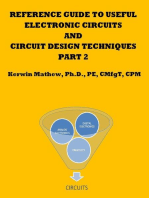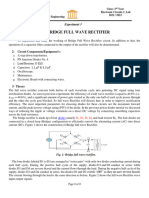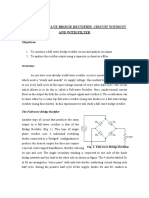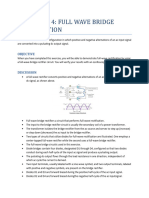Lab 05
Uploaded by
degag64086Lab 05
Uploaded by
degag64086EXPERIMENT NO -6
BRIDGE RECTIFIERS
AIM:
1. To observe waveform at the output of bridge rectifier with and without filter capacitor.
2. To measure DC voltage, DC current, ripple factor with and without filter capacitor.
EQUIPMENT:
1. Transformer 12 V AC, 500 mA - 1 No._______________
2. Diode 1N4007 - 4 No. ______________
3. or 1 A bridge rectifier package
4. Resistor 10K
5. Capacitor 1000µF
6. Toggle Switch
Construct circuit on the general purpose PCB. Keep toggle switch OFF to perform practical of
full wave rectifier without filter capacitor and ON to connect filter capacitor.
THEORY:
The Bridge rectifier is a circuit, which converts an ac voltage to dc voltage using both half cycles
of the input ac voltage. The Bridge rectifier circuit is shown in the following figure. The circuit
has four diodes connected to form a bridge. The ac input voltage is applied to the diagonally
opposite ends of the bridge. The load resistance is connected between the other two ends of the
bridge. For the positive half cycle of the input ac voltage, diodes D1 and D2 conduct, whereas
diodes D3 and D4 remain in the OFF state. The conducting diodes will be in series with the load
resistance RL and hence the load current flows through RL. For the negative half cycle of the input
ac voltage, diodes D3 and D4 conduct whereas, D1 and D2 remain OFF. The conducting diodes
D3 and D4 will be in series with the load resistance R L and hence the current flows through RL in
the same direction as in the previous half cycle. Thus a bi-directional wave is converted into a
unidirectional wave.
46 Electronic Devices and Circuits (EE-300) | [Military College of Signals]
The circuit diagram of the bridge rectifier with filter capacitor is shown in the following figure.
When capacitor charges during the first cycle, surge current flows because initially capacitor acts
like a short circuit. Thus, surge current is very large. If surge current exceeds rated current
capacity of the diode it can damage the diode. To limit surge current surge resistance is used in
series as shown in the figure. Similar surge resistance can be used in half wave as well as center-
tapped full wave rectifier also. Bridge rectifier package (combination of four diodes in form of
bridge) is easily available in the market for various current capacities ranging from 500 mA to
30A.
For laboratory purpose you can use 1A package.
47 Electronic Devices and Circuits (EE-300) | [Military College of Signals]
CIRCUIT DIAGRAM:
Advantages of bridge rectifier:
• No center tap is required in the transformer secondary hence transformer design is
simple. If stepping up and stepping down not required than transformer can be
eliminated. (In SMPS used in TV and computer, 230V is directly applied to the input of
bridge rectifier).
• The PIV of the diode is half than in center tap full wave rectifier
• Transformer utilization factor is higher than in center tapped full wave rectifier
• Smaller size transformer required for given capacity because transformer is utilized
effectively during both AC cycles.
Disadvantages of bridge rectifier:
• Requires Four diodes (But package is low cost)
• Forward voltage drop across two diodes. This will reduce efficiency particularly when
low voltage (less than 5V) is required.
• Load resistance and supply source have no common point which may be earthed.
48 Electronic Devices and Circuits (EE-300) | [Military College of Signals]
CIRCUIT DIAGRAM:
OBSERVATIONS:
Waveforms:
[1] Without filter capacitor: Input Waveform at secondary of transformer:
Output waveform:
49 Electronic Devices and Circuits (EE-300) | [Military College of Signals]
[1] With filter capacitor: Input Waveform at secondary of transformer:
Output waveform:
CALCULATIONS:
[1] Without filter capacitor
AC Input voltage (rms) Vrms= ___________
DC output voltage VDC = ___________
DC current: IDC =______________
AC output voltage (Ripple voltage) Vr: __________
Ripple factor: (Vr/VDC) = ______________
[2] With filter capacitor
AC Input voltage (rms) Vrms= ___________
DC output voltage VDC = ___________
DC current: IDC =______________
AC output voltage (Ripple voltage) Vr: __________
Ripple factor: (Vr/VDC) = ______________
50 Electronic Devices and Circuits (EE-300) | [Military College of Signals]
CONCLUSION:
POST LAB QUESTIONS:
1. What is the mathematical expression for ripple factor. What is the ripple factor of bridge
rectifier without filter capacitor?
2. What is the mathematical relationship between rms AC input and DC output from the bridge
rectifier with and without filter capacitor? If transformer of 24V is used, what is the DC output
voltage with and without filter capacitor?
3. What is the PIV necessary for the diode if transformer of 12-0-12 V is used?
4. What is the efficiency of full wave bridge rectifier?
51 Electronic Devices and Circuits (EE-300) | [Military College of Signals]
You might also like
- PR-005-D EAA-ProAssure Base User OperationsNo ratings yetPR-005-D EAA-ProAssure Base User Operations207 pages
- Full Wave Bridge Rectifier: Experiment No. 6No ratings yetFull Wave Bridge Rectifier: Experiment No. 65 pages
- Reference Guide To Useful Electronic Circuits And Circuit Design Techniques - Part 1From EverandReference Guide To Useful Electronic Circuits And Circuit Design Techniques - Part 12.5/5 (3)
- 18-Full Wave Rectifier With Filter and Regulator+earth Resistance Measurement-20-12-2022No ratings yet18-Full Wave Rectifier With Filter and Regulator+earth Resistance Measurement-20-12-20225 pages
- Reference Guide To Useful Electronic Circuits And Circuit Design Techniques - Part 2From EverandReference Guide To Useful Electronic Circuits And Circuit Design Techniques - Part 2No ratings yet
- Electronic Devices Lab - Study of Diode Rectifiers - Mid Term - Fall 22-23 - ACSNo ratings yetElectronic Devices Lab - Study of Diode Rectifiers - Mid Term - Fall 22-23 - ACS11 pages
- Lab#3A: Full-Wave Bridge Rectifier Circuit Without and With FilterNo ratings yetLab#3A: Full-Wave Bridge Rectifier Circuit Without and With Filter6 pages
- Ecgr3155-Experiment 4-Diodes and Bridge RectifiersNo ratings yetEcgr3155-Experiment 4-Diodes and Bridge Rectifiers8 pages
- EXP 02 STUDY OF DIODE RECTIFIER CIRCUITS (1)No ratings yetEXP 02 STUDY OF DIODE RECTIFIER CIRCUITS (1)3 pages
- Durgapur: National Institute of TechnologyNo ratings yetDurgapur: National Institute of Technology10 pages
- Lab Report 2 Phy547: Experiment 2: Zener Diode and Power SupplyNo ratings yetLab Report 2 Phy547: Experiment 2: Zener Diode and Power Supply8 pages
- Basic Electronics Lab: Laboratory ManualNo ratings yetBasic Electronics Lab: Laboratory Manual10 pages
- Electronic Devies and Circuits Lab Report: Experiment # 4No ratings yetElectronic Devies and Circuits Lab Report: Experiment # 48 pages
- Advantages of Bridge Rectifier:: E.C. Department, Government Engineering College, RajkotNo ratings yetAdvantages of Bridge Rectifier:: E.C. Department, Government Engineering College, Rajkot1 page
- Basic Electrical Engineering Laboratory Exp 3No ratings yetBasic Electrical Engineering Laboratory Exp 35 pages
- InDesign CC21 Student Packet - P2 Conference PosterNo ratings yetInDesign CC21 Student Packet - P2 Conference Poster9 pages
- Bajaj Finserv (2nd Visit) Recruitment Drive-Interview On 17th Sept'2022 For 2023 Graduating BatchNo ratings yetBajaj Finserv (2nd Visit) Recruitment Drive-Interview On 17th Sept'2022 For 2023 Graduating Batch4 pages
- The Transition of Croatian Seaports Into Smart Ports - MIPRO 2019 Saša AksentijevićNo ratings yetThe Transition of Croatian Seaports Into Smart Ports - MIPRO 2019 Saša Aksentijević5 pages
- Unit 2 Knowledge Representation and ReasoningNo ratings yetUnit 2 Knowledge Representation and Reasoning68 pages
- ANSYS Mechanical Introduction To Structural Nonlinearities: 14. 5 ReleaseNo ratings yetANSYS Mechanical Introduction To Structural Nonlinearities: 14. 5 Release8 pages
- ICT 34 Data Structures and Analysis of Algorithm100% (1)ICT 34 Data Structures and Analysis of Algorithm9 pages
- Swahili Stories From Arab Sources, With An English TranslationNo ratings yetSwahili Stories From Arab Sources, With An English Translation180 pages
- Ghost in The Shell 2017 Bluray 1080P Truehd Atmos 7 1 Avc Remux-FramestorNo ratings yetGhost in The Shell 2017 Bluray 1080P Truehd Atmos 7 1 Avc Remux-Framestor2 pages
- Reference Guide To Useful Electronic Circuits And Circuit Design Techniques - Part 1From EverandReference Guide To Useful Electronic Circuits And Circuit Design Techniques - Part 1
- 18-Full Wave Rectifier With Filter and Regulator+earth Resistance Measurement-20-12-202218-Full Wave Rectifier With Filter and Regulator+earth Resistance Measurement-20-12-2022
- Reference Guide To Useful Electronic Circuits And Circuit Design Techniques - Part 2From EverandReference Guide To Useful Electronic Circuits And Circuit Design Techniques - Part 2
- Electronic Devices Lab - Study of Diode Rectifiers - Mid Term - Fall 22-23 - ACSElectronic Devices Lab - Study of Diode Rectifiers - Mid Term - Fall 22-23 - ACS
- Lab#3A: Full-Wave Bridge Rectifier Circuit Without and With FilterLab#3A: Full-Wave Bridge Rectifier Circuit Without and With Filter
- Ecgr3155-Experiment 4-Diodes and Bridge RectifiersEcgr3155-Experiment 4-Diodes and Bridge Rectifiers
- Lab Report 2 Phy547: Experiment 2: Zener Diode and Power SupplyLab Report 2 Phy547: Experiment 2: Zener Diode and Power Supply
- Electronic Devies and Circuits Lab Report: Experiment # 4Electronic Devies and Circuits Lab Report: Experiment # 4
- Advantages of Bridge Rectifier:: E.C. Department, Government Engineering College, RajkotAdvantages of Bridge Rectifier:: E.C. Department, Government Engineering College, Rajkot
- InDesign CC21 Student Packet - P2 Conference PosterInDesign CC21 Student Packet - P2 Conference Poster
- Bajaj Finserv (2nd Visit) Recruitment Drive-Interview On 17th Sept'2022 For 2023 Graduating BatchBajaj Finserv (2nd Visit) Recruitment Drive-Interview On 17th Sept'2022 For 2023 Graduating Batch
- The Transition of Croatian Seaports Into Smart Ports - MIPRO 2019 Saša AksentijevićThe Transition of Croatian Seaports Into Smart Ports - MIPRO 2019 Saša Aksentijević
- ANSYS Mechanical Introduction To Structural Nonlinearities: 14. 5 ReleaseANSYS Mechanical Introduction To Structural Nonlinearities: 14. 5 Release
- Swahili Stories From Arab Sources, With An English TranslationSwahili Stories From Arab Sources, With An English Translation
- Ghost in The Shell 2017 Bluray 1080P Truehd Atmos 7 1 Avc Remux-FramestorGhost in The Shell 2017 Bluray 1080P Truehd Atmos 7 1 Avc Remux-Framestor

























































































